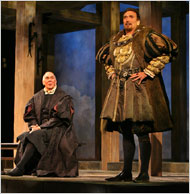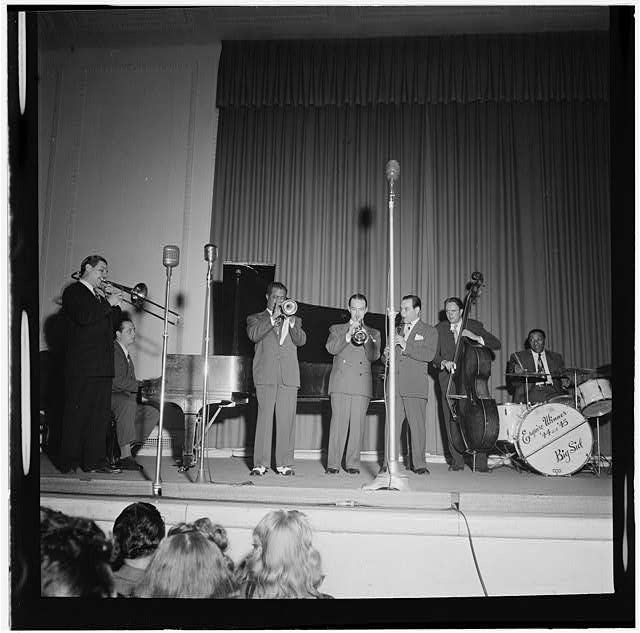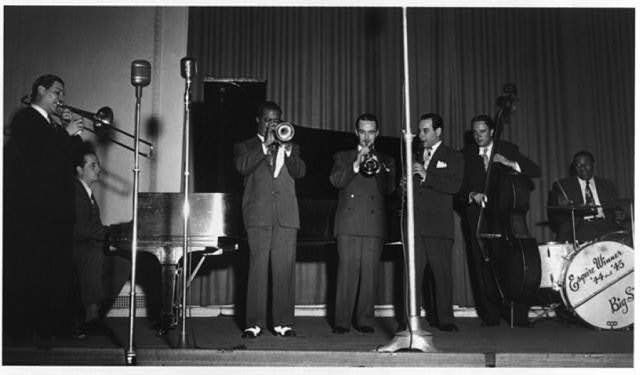Maestro, BBC-2’s latest venture into reality-TV programming, has yet to be imported to the United States, no doubt because it’s a trifle arty for the average American TV viewer. In the series, which ran throughout August and September, eight semi-celebrities took crash courses in orchestral conducting, then competed for a chance to conduct the BBC Concert Orchestra as part of a televised concert. (The comedian won.) Not altogether surprisingly, Maestro attracted quite a bit of attention in the British press, not all of it favorable. Norman Lebrecht, for instance, called it “a new nadir in arts broadcasting” and “a calculated insult to art.”
It happens that I know a thing or two about conducting–I did a fair amount of it in my college days–and so I decided that Maestro would make a suitable topic for my “Sightings” column in tomorrow’s Wall Street Journal. Is it really true, as the producers of Maestro seem to suggest, that you don’t have to be a trained musician in order to successfully lead a symphony orchestra? Or might there possibly be more to the art of conducting than waving a wooden stick? To find out, pick up a copy of Saturday’s Journal and see what I have to say.
UPDATE: Read the whole thing here.
Watch Sue Perkins, the winner of the Maestro competition, conduct the first movement of Beethoven’s Fifth Symphony here:
Archives for October 2008
TT: Almanac
“If you rest, you rust.”
Helen Hayes, My Life in Three Acts
CAAF: Morning coffee
Some ghoulish entertainment in preparation for Halloween:
• Elizabeth Bowen’s “The Demon Lover.” Set during the Blitz, the story is one of the spooky stories recommended by James Hynes which I pointed to yesterday and can be found in the excellent Norton Book of Ghost Stories , edited by Brad Leithauser. Very compressed, gorgeous & hair-raising — print it out and read in a crowded place.
• The old Scottish ballad the story is based on.
TT: So you want to see a show?
Here’s my list of recommended Broadway, off-Broadway, and out-of-town shows, updated weekly. In all cases, I gave these shows favorable reviews (if sometimes qualifiedly so) in The Wall Street Journal when they opened. For more information, click on the title.
Warning: Broadway shows marked with an asterisk were sold out, or nearly so, last week.
BROADWAY:
• Alfred Hitchcock’s The 39 Steps (comedy, G, suitable for bright children, reviewed here)
• August: Osage County (drama, R, adult subject matter, reviewed here)
• Avenue Q (musical, R, adult subject matter and one show-stopping scene of puppet-on-puppet sex, reviewed here)
• Boeing-Boeing (comedy, PG-13, cartoonishly sexy, reviewed here)
• Equus (drama, R, nudity and adult subject matter, closes Feb. 8, reviewed here)
• Gypsy (musical, PG-13, adult subject matter, reviewed here)
• The Little Mermaid (musical, G, entirely suitable for children, reviewed here)
 • A Man for All Seasons * (drama, G, too intellectually demanding for children of any age, extended through Dec. 14, reviewed here)
• A Man for All Seasons * (drama, G, too intellectually demanding for children of any age, extended through Dec. 14, reviewed here)
• South Pacific * (musical, G/PG-13, some sexual content, brilliantly staged but unsuitable for viewers acutely allergic to preachiness, reviewed here)
OFF BROADWAY:
• The Fantasticks (musical, G, suitable for children capable of enjoying a love story, reviewed here)
IN CLEVELAND:
• Noises Off (farce, PG-13, some mild sexual content, reviewed here)
CLOSING SATURDAY IN CHICAGO:
• R.U.R. (serious comedy, PG-13, adult themes, reviewed here)
CLOSING SUNDAY OFF BROADWAY:
• Enter Laughing (musical, PG-13, full of sex jokes, reviewed here)
TT: Almanac
“When statesmen forsake their own private conscience for the sake of their public duties, they lead their country by a short route to chaos.”
Robert Bolt, A Man for All Seasons
CAAF: Afternoon coffee
• James Hynes recommends ten spooky stories for midnight reading. (Via Maudie.)
• John Updike talks to Emily Nussbaum about The Widows of Eastwick, his follow-up to 1984’s Witches of Eastwick. (Via Sarah.)
• Vampire bats, leeches, chiggers and bed bugs are among the bloodsuckers featured in Dark Banquet, a new book by biologist Bill Schutt which, as it happens, I trotted to the bookstore last night to purchase. (Via Jenny.)
TT: A glimpse of history
 On May 17, 1947, Louis Armstrong gave an all-star concert at New York’s Town Hall that changed his life. He had been leading a touring big band since 1929, but World War II brought the Swing Era to an end, and by 1947 Armstrong knew that he had to find a different way to package himself for postwar audiences. He did so at the Town Hall concert, which teamed him with a small group whose members included Sid Catlett, Bobby Hackett, and Jack Teagarden. As I wrote in A Cluster of Sunlight: The Life of Louis Armstrong:
On May 17, 1947, Louis Armstrong gave an all-star concert at New York’s Town Hall that changed his life. He had been leading a touring big band since 1929, but World War II brought the Swing Era to an end, and by 1947 Armstrong knew that he had to find a different way to package himself for postwar audiences. He did so at the Town Hall concert, which teamed him with a small group whose members included Sid Catlett, Bobby Hackett, and Jack Teagarden. As I wrote in A Cluster of Sunlight: The Life of Louis Armstrong:
It was, for one thing, the first time that he had ever given a full-evening concert with a combo, and it appears to have been the first time since 1926 that he had appeared in public as the leader of a small group of his own. Not that he needed a good band to play well. “I work with two bands, the one on stage and the one in my head,” he would later tell Ruby Braff. “If they sound good on stage, O.K., I’ll play with them. If not, I just turn up the volume of the band in my head.” But the band with which he was playing at Town Hall that night sounded very good indeed…
At the time, comparatively little fuss was made over the event, which went unmentioned in the New York Times, Time, and The New Yorker. Only the jazz press took note of the occasion: Down Beat‘s review was headed “Satchmo’s Genius Still Lives,” while The Melody Maker ran a piece by a correspondent who reported that Armstrong’s playing “had all the freshness and vigour of the early Hot Five and Seven days. He never strove for effects, never played to the gallery.” But one person in the audience was listening with the closest possible attention. Joe Glaser, Armstrong’s manager, who was sitting in a box seat, knew at once that his troubles were over. Not only had Armstrong proved himself capable of thrilling a crowd without the support of a big band, but in Jack Teagarden he had found the foil of a lifetime. Like the businessman he was, Glaser struck while the iron was smoking hot. He signed Teagarden to a long-term contract on Monday morning, then gave the members of the big band two months’ notice.
Three months after that, Armstrong opened at Billy Berg’s, a Los Angeles nightclub, leading a six-piece combo whose other members included Sid Catlett and Jack Teagarden. The engagement was a huge success, and for the rest of his life Armstrong toured the world with the band that Glaser later dubbed “the All Stars.”
 Rarely have microphones been present at so historically significant a one-night stand as Armstrong’s 1947 Town Hall concert, but Ernie Anderson, the promoter who persuaded Glaser to let him present the concert, took care to record it, and the resulting album leaves no possible doubt that it was as good as everybody remembered. Fortunately, the great jazz photographer Bill Gottlieb was also present, and took a beautiful group shot of Armstrong and his musicians in full cry. A cropped version of the photo was published two months later in Down Beat, but the original vanished into Gottlieb’s files, and it didn’t resurface until he left his personal archive of sixteen hundred prints and negatives to the Library of Congress, which has created an online collection of Gottlieb’s work.
Rarely have microphones been present at so historically significant a one-night stand as Armstrong’s 1947 Town Hall concert, but Ernie Anderson, the promoter who persuaded Glaser to let him present the concert, took care to record it, and the resulting album leaves no possible doubt that it was as good as everybody remembered. Fortunately, the great jazz photographer Bill Gottlieb was also present, and took a beautiful group shot of Armstrong and his musicians in full cry. A cropped version of the photo was published two months later in Down Beat, but the original vanished into Gottlieb’s files, and it didn’t resurface until he left his personal archive of sixteen hundred prints and negatives to the Library of Congress, which has created an online collection of Gottlieb’s work.
I was lucky enough to be casually acquainted with Gottlieb, who died a couple of years ago, and I knew as soon as I started choosing the illustrations for A Cluster of Sunlight that his Town Hall photograph would have to be included. I’m pleased to say that his son Edward has given me permission to reprint this essential document of the most consequential performance of Louis Armstrong’s life. It isn’t as well known as it ought to be, perhaps because it isn’t all that dramatic, but even so, no Armstrong biography could possibly be complete without it.
TT: Snapshot
The George Shearing Quintet plays “Conception”:
(This is the latest in a weekly series of arts-related videos that appear in this space each Wednesday.)
